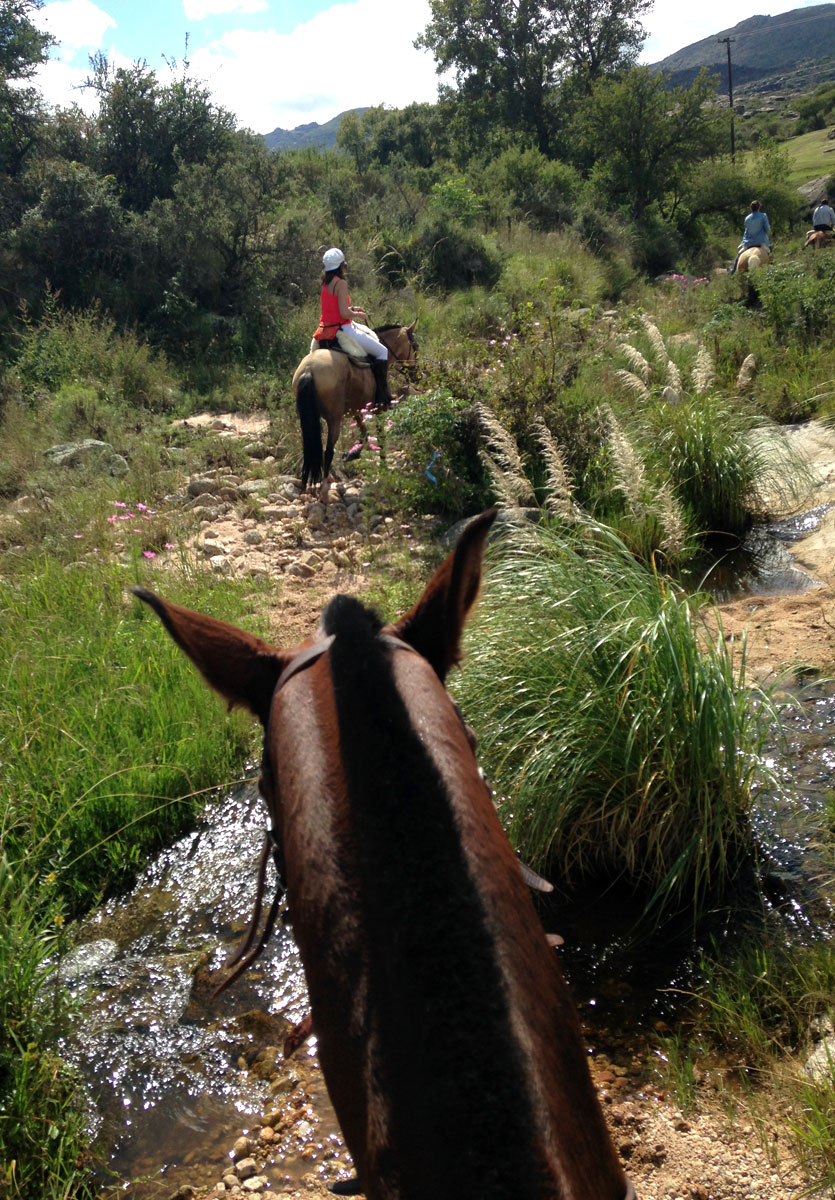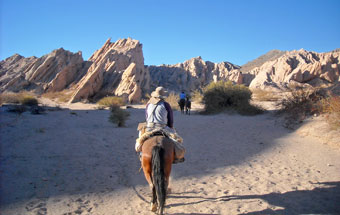Horse riding safety tips
By: Nestor Imberti Posted: 25/02/2020
The instructions from our Ampascachi’s experts will make you feel safer on the saddle seat. Wear a helmet and safety boots, make good use of the stirrups and learn good skills to handle your horse.

Taking risk into account
Horse riding involves a certain degree of risk, like in every activity or sport. Depending on what you do, that risk may be greater or lower.
When we say that a horse is a living being that might, for example, get frightened and show an unpredicted behaviour that could unbalance you on the saddle, or it could stumble and fall, consequently, you could also fall to the ground.
It must be borne in mind that there are many components that affect that risk, such as the horse’s height, the speed at which you are riding, the type of trail, if you are in the countryside, the obstacles that there may be in the riding tracks, etc.
In view of this, someone might conclude that riding a horse is more dangerous than riding a motorcycle. But don’t be afraid, because it is possible to learn how to ride a horse safely, like in every activity you do every day.
If you learn to ride carefully and observe certain rules, you’ll see how you can have a safe riding experience and, in that way, you will be able to enjoy riding in the countryside and get rid of city stress, or practice an equestrian sport in a riding track.

Would you like to be part of a group with an equestrian soul?
Join the Ampascachi Community. Obtain exclusive benefits for your holidays.
We tell you how to start, train and take care of your horse.
Interviews with direct providers of riding tours around the world.
Opinions of outstanding equine scientists and personalities in the equestrian sport world.
How to get ready for our first steps?
The safest way to learn how to ride is with a qualified and experienced instructor or trainer, and with a docile horse, which can belong to you or to the equestrian centre where you are learning. In any case, learning is based on putting rules and knowledge into practice, because you cannot learn how to ride a horse by only reading the theory.
Once you have acquired practice in riding, you can read or watch videos that, depending on your interest in improving, will help you learn detailed notions about horses, taming and horsemanship, but remember you have to practice until you do it well.
Instructors or trainers will teach you how to develop safety riding skills, such as how to mount a horse and sit on it, how to hold the reins, how to walk, trot or gallop, how to make transitions between those gaits, to stop, to turn, etc. They will also be there with you to prevent you from developing bad habits and making mistakes that might harm both the horse and you, or even another person near you.


Horse riding safety tips
We have listed a number of guidelines you should follow in order to have a safe riding experience:
- At the beginning, it is advisable to ride a docile horse, suitable for a beginner’s skill level, and which is well tamed and used to the typical mistakes that a green rider might make.
- As we said before, start to learn how to ride with an instructor or a trainer. Don’t try to do it by yourself. In that way, you will be safe as you become skilled enough to improve your own safety.
- Wear a helmet to protect your head. Most accidents in horse riding cause damage to the head and that could be avoided with a helmet. Oddly enough, many experienced riders refuse to wear a helmet, especially when they go riding in open country, but this is a reckless thing to do, since even the most skilled riders could fall down and bang their head. So, wear a helmet whenever you go riding.
- If you ride a young or a newly tamed horse, try to do it together with another rider and go to those places the horse already knows, at first. Under these circumstances, it is not advisable to go riding alone.
- When you ride in a group, try to keep a minimum distance of at least the length of the horse in case one of the horses kicks and, in that way, it won’t hit you. Or in case there is a fall or an unexpected reaction, you can avoid them.
- It is advisable to wear a safety vest, and check that the cinch is tight enough and that the saddle seat is well placed before mounting the horse.
- Perform regular horse tack checks (reins, headstalls, cinches, saddles, halters, etc.) to make sure that nothing is broken or damaged, which might put you at risk while riding.
- If your horse got overexcited for whatever reason, it’s preferable to dismount and calm him down from the ground.
- Don’t run unless you do it on flat terrain and have the adequate degree of experience to gallop.
- Wear resistant boots with a minimum anti-slip strip and with heals of at least 2.5 cm. Rest your feet correctly in the stirrups placing the ball of your foot on the tread, don’t jam it too far in because if you should fall, it could stay caught in the stirrup, which is very dangerous.
- Learn how to do an emergency dismount. It is better to handle any unsettling situation from the ground, that is to say, a quick dismount increases safety.
- Learn how to do an emergency stop and turn.
- Learn how to fall. Although this won’t prevent you from getting hurt, learning to fall off the horse and roll away might help you avoid serious injuries.
- Very important: always pay attention when you ride and keep everything under control. This is the best strategy to avoid a fall or an accident if your horse reacts unexpectedly because he got scared of something. If you are paying attention, you will be able to redirect the situation, especially if you are trotting fast or galloping.
- Whenever possible, try to go riding with somebody else, and if you ride alone, make sure to tell someone where you are going and the time when you think you’ll come back. In that way, if you are not back by then, you could be located. In both cases, riding with another person or alone, remember to take a mobile phone with you, and if there is no signal for phones, take a radio transmitter.
- Avoid riding along roads because vehicles or trucks could spook your horse and cause an accident.
- Don’t let the horse gallop on the way back home or back to the starting point. This could cause a bad behaviour in the horse – the habit of rushing back, when they sense they are going back. In such case, it will be difficult to control the horse. Besides, a horse that has been going fast shouldn’t stop all at once. That could cause cramps or other kinds of problems to the horse. Consequently, reduce the horse’s speed at least one kilometre before you get to the starting point and make him walk so he can relax.
- When you ride in a group, you must try to set the gait speed you will use according to the less-experienced riders.
- Be careful with children since they could be moving near your horse while you ride. They should learn to move slowly, without sudden movements, and avoid yelling because that could scare or distract the horse.

Take these tips into consideration but you don’t have to remember them by heart. As you learn to ride and with practice, you will assimilate all these actions that we described in this article and, in a short time, you will begin to do them, as a habit. Then, you won’t have to make an effort at remembering them.
Now that we have told you everything that may be useful for you, especially those aspects related to safety, we hope you join us in our passion for horse riding, which is wonderful.
Are you passionate about horses, too? Do you want to learn how to train them?
Download our free eBook Horse training step by step. When you see how your horse learns and begins to understand your signs and aids, you will be filled with joy.
And if you want to be a professional horse trainer and get field-based training, you should check out our training program. You will have the opportunity to live in our equestrian centre and experience our full training process with young horses.
~
THIS COULD ALSO BE INTERESTING

Learn how to ride a horse – Part I
Learning to ride a horse is something wonderful and once you bond with a horse and discover the horse-riding passion, especially if you ride in the countryside, you will never stop.

Learn how to ride a horse – Part II
It is never too late to learn to ride a horse, so take note of our basic tips for beginners. Go horse riding in a group and enjoy nature!

Visiting Northern Argentina on Horseback
Travelling around the north of Argentina on horseback offers you some wonderful options. Riding a horse, you will go through the awesome landscapes of the Calchaqui Valleys.
~
WHAT IS YOUR OPINION? LEAVE A COMMENT
Your comments
Amazing article! I really enjoyed it and it reminded me why I am passionate about horses ... Actually, I’ve been feeling very lost because I was a little scared, but thanks to this kind of articles, I can feel confident to perform this task. For those who are also at a loss, you can watch the free training session here. I hope it helps someone: https://hotm.art/QeDASCLaMenteEquinade0a100
I found it helpful when you said that the best strategy to avoid a fall or an accident is to keep everything under control. Well, I wonder if this is also the strategy of equestrians, especially women who have been making names. Due to my interest, I will find time to read and listen to news about women in the horse racing industry. Thanks! https://rodeosportsnation.com/category/womens-rodeo-news/
Planning your horse riding holidays?
Join the Ampascachi Community. You will get exclusive advantages and guidance for your next horse riding holiday.


 German
German French
French Spanish
Spanish